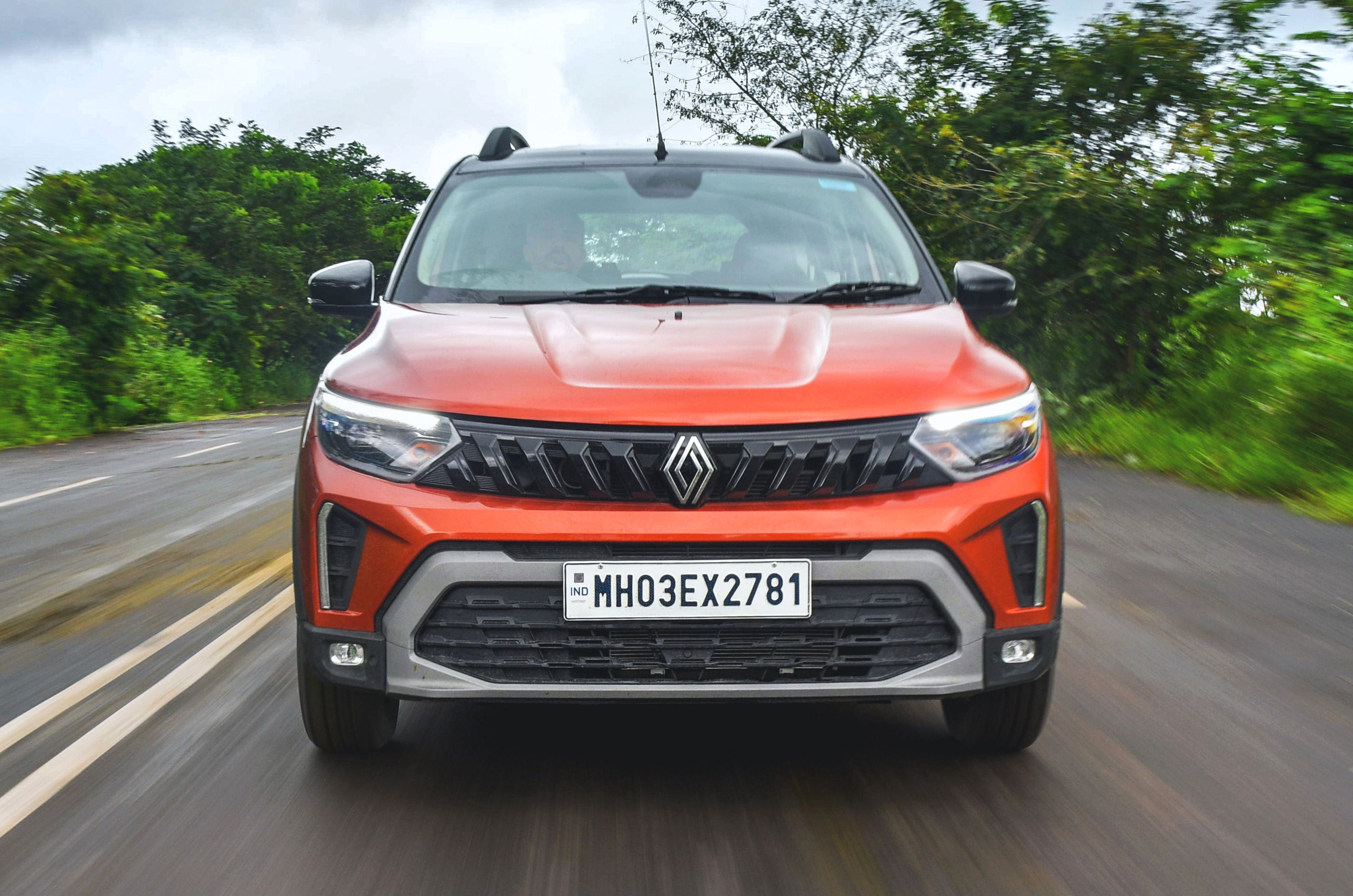When it originally launched in August 2019, the Renault Triber enjoyed strong initial demand, racking up 100,000 sales in just 30 months. Since then, however, demand has slowed considerably, halving to about 1,500 units a month. That number though still makes up almost half of Renault India’s sales, thus making the Triber an important product for the French car maker. With the brand now bullish on India and taking full control of its manufacturing JV with Nissan, it’s now preparing for a slew of new models on a new platform, and also updating the current CMF-A+ based products like the Triber.
Renault Triber design and engineering: 7/10
Sharper front end brings the Triber bang up to date

Much like the Kiger, the Triber’s facelift is largely focussed at the front end. There’s a new bonnet, which now has sharp creases, indentations and a flat leading edge. Renault’s diamond-shaped logo sits proud on a new gloss black grille that fills the space between the headlights quite nicely. The headlights are the same shape as before, but they are now LED units complemented by LED fog lamps. In an effort to give the Triber a more SUV-like vibe, the bumper is boxier, with chunky silver trim adding some visual heft.
In profile, not a lot has changed. The 15-inch wheels get new plastic covers that once again do a superb job of mimicking alloys, and if you prefer the real deal, they are available as an option. Decals on the lower portion of the doors now have some patterns in them, while the door handles are finished in gloss black to match the roof. Functional roof rails – capable of handling loads of up to 50kg – complete the look.

It’s a similar story at the rear, with the biggest change being a move to LED tail-lamps connected by a gloss black trim piece. The rear bumper also gets a boxier design to match the front, while a Triber script on the lift gate finishes things off nicely. Overall, Renault has quite smartly redesigned the MPV to deliver significant visual impact with minimal outlay.
Renault Triber interior space and comfort: 9/10
The lighter interior theme makes the cabin look more airy than before.

The Triber uses a new dashboard, similar to the one in the updated Kiger, moving the infotainment screen to the top while bringing the HVAC vents lower down. While the previous model used a mix of black and beige materials, this update relies more on what Renault calls “Greige” for an airier ambience. Gone is the silver dash trim, replaced by a matte wood piece with diamond patterns. While fake wood might sound tacky in this day and age, this element looks better than you’d imagine. The steering wheel has also been carried over from the Kiger, though in a strange cost-cutting move, only the section between the ten and two positions is wrapped in leather.
Storage space is well thought out, with the dash getting two large gloveboxes, while the centre console features a shelf for a smartphone, a separate slot with a wireless charger, two small cupholders and a nifty cooled storage bin. Door pockets are present too, though they aren’t deep enough to hold large water bottles.

As before, the amount of space the Triber packs into a sub-4-metre footprint is truly impressive. While some extra lumbar and thigh support would be welcome, the front seats are adequately comfortable. The driver also gets an armrest, though this can get in the way of gear changes. Shoulder, head and elbow room are more than sufficient, but the driver’s footwell is cramped and lacks a dead pedal.
The second row is actually more comfortable than the first, with better thigh support and adjustable headrests. Dedicated AC vents are neatly integrated into the B-pillars, with a knob to control fan speed placed between the front seats. The seat splits 60:40, slides to free up more legroom and even reclines. With it pushed all the way back, there is enough knee-room to appease six-footers, though they might not be so happy when seated three abreast.

The real USP, however, is the third row. Access is relatively easy with the middle row tumbling forward at the pull of a lever. To seat anyone larger than a child, the middle row will need to be pushed forward, but once that’s done, it is surprisingly comfortable, especially so, over short stints. What’s disconcerting, however, is the proximity of the tailgate to the passenger’s head.
Renault Triber features and safety: 8/10
Facelift adds cruise control, auto headlamps and rain sensing wipers; 6 airbags now standard.

Renault has added a few new features with this facelift, the most notable being cruise control, auto headlamps and rain-sensing wipers. The 8-inch infotainment screen — despite being the same size as before — has received a new UI. It isn’t very responsive or crisp, but it makes up for it with wireless Apple CarPlay and Android Auto. The digital driver’s instrument cluster is unchanged, but it is easy to read and logically laid out.
Safety has also been enhanced, with six airbags and ISOFIX mounts now included as standard. It also gets ABS, EBD, ESP, traction control, hill-start assist, a tyre pressure monitoring system, and parking sensors at both ends. It’s also pertinent to note that the earlier Triber scored four stars in Global NCAP tests.
Renault Triber performance and refinement: 5/10
Naturally aspirated 1.0-litre engine is adequate in the city but struggles on the highway.

Powering the Triber is the same 999cc, three-cylinder engine it has had since launch. Outputs are a modest 72hp and 96Nm, sent to the front wheels via a 5-speed manual or AMT. While this facelift was the perfect opportunity to drop in the turbo petrol from the Kiger, that would have bumped up the price. As it stands, performance is just about adequate in the city. Keeping up with the flow of urban traffic is not an issue, but on the highway, making overtakes requires a downshift or two. This issue is exaggerated when carrying a full load of passengers, requiring you to wring the engine for all it’s worth, which exposes its shortcomings in refinement. That three-cylinder thrum can get quite loud, accompanied by a bit of transmission whine.
Shifts on the manual are heavier than you might expect, as is the clutch, which also has a high bite point. An AMT alleviates this though shifts are not smooth, it does a decent job of keeping the engine on the boil though. Unfortunately Renault allows only the top-spec Emotion trim to be optioned with the AMT.
Renault Triber ride comfort and handling: 7/10
Ride and handling is good and well composed, let down by light steering.
In typical French fashion, the Triber rides with a maturity belying its size. While there is an underlying firmness to the suspension — a result of the fact it has to carry seven and not collapse — it never really gets uncomfortable. Sharp jolts do make it through, but it handles most of what our roads throw at it with composure. Another positive is its stability at speed, which is remarkable for a vehicle that weighs under a tonne. What lets it down, though, is the light and lifeless steering — great when parking, but disconcerting as speeds rise.
Renault Triber mileage and fuel economy: 7/10
ARAI claimed mileage of 19kpl for the manual and 18.29kpl for the AMT.
The ARAI mileage figures for the previous version of the Triber stood at 19kpl for the manual and 18.29kpl for the AMT. A CNG variant is also available via a dealer-installed CNG kit, with the factory warranty still applicable.
Renault Triber price and verdict: 7/10
Excellent packaging and value, however performance is sub par.

There is no hiding the fact that this facelift is largely cosmetic; however, it has done a decent job of bringing the Triber up to date. Unfortunately, its biggest flaw — performance, or the lack of it — also remains. At a starting price of Rs 5.76 lakh, though, it’s hard to argue with the value it offers. For what is distinctly hatchback money, the Triber provides a lot more genuine practicality and versatility. As a family car that can comfortably carry four and plenty of luggage — or occasionally take in seven — there is nothing else out there. The Triber certainly has found a niche and fits into it perfectly.



